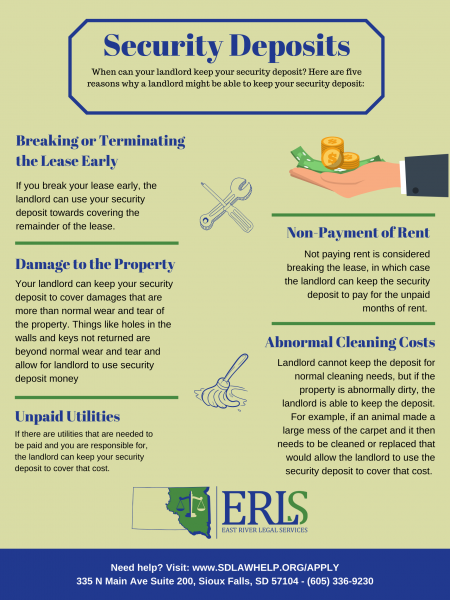Landlord-Tenant - Deposits
DEPOSITS
How can a tenant prevent deposit hassles?
Most landlords require a security deposit (aka damage deposit, rent deposit, etc.) to be paid by a tenant at the beginning of the lease. Before moving in, the tenant should inspect the rental unit with the landlord and write out a list of any damages, whether large or small, that have already been done to the rental unit (spots on carpets, broken windows, marks on wall, stove not working, etc.) Both the landlord and tenant should sign the paper and each keep a copy. This will protect both parties from later misunderstandings about what damage the tenant caused. If the landlord is unwilling to make the move-in inspection, the tenant should make one anyway and mail a Certified Return Receipt copy of the damaged list to the landlord. Keeping the paperwork, the tenant can prove, if he/she needs to, that the landlord knew of the old damages to the old rental unit when the tenant moved in.
A landlord cannot require a security deposit in excess of one month’s rent “special conditions” exist which pose a danger to the condition of the premises. This may include large or many pets or other things which may likely cause damage, by the tenant, to the rental unit.
How can a tenant get the security deposit back?
When a tenant moves out, the landlord must return the deposit or send a written statement to the tennant showing specific reason(s) for not returning the deposit. The refund or statement must be sent within two (2) weeks after the tenant has moved out and the landlord has received the tenant’s mailing address or delivery instructions. The landlord may keep from the deposit only such money as is necessary to either cover unpaid rent or to return the rental unit to the way it was at the start of the tenant’s leasing of the rental unit. Costs to repair “ordinary wear and tear” cannot be included in the money the landlord may keep. The tenant may also demand a listing of how the deposit money was spent by the landlord. This must be given to the tenant within forty-five (45) days after the tenant moves out. Every time a tenant moves, he/she should write a letter and send a copy Certified Return Receipt to the landlord notifying the landlord of the tenant’s new address and demanding the return of the deposit. The letter should also ask for a listing of how any of the deposit money kept by landlord was used.
If the landlord keeps all or part of the deposit without good reason or fails to send the tenant the proper notices, the landlord can be sued in Small Claims Court for the deposit return. Up to $200 can also be awarded to the tenant for punitive (punishment) damages if, the landlord, in “bad faith” (knowing law and not following), fails to refund all or part of the deposit or, the landlord does not provide the tenant with the 2-week statement or 45-day itemized listing, as required by law.
What happens to property left on rental premises?
The landlord must handle property left on the rental premises, by a tenant who has moved, as follows: Property having a total reasonable value which does not exceed $500 is, under law, abandoned by the tenant after ten (10) days of the tenants move from the rental unit. The property may then be disposed of by the landlord according to abandoned property laws. Property with a total reasonable value of over $500 must be stored by the landlord for thirty (30) days after the tenant moves. If the tenant does not claim the property, the landlord may treat the property as abandoned and dispose of it according to law. If the property is claimed by the tenant, the landlord can make tenant pay reasonable handling and storage costs.
Additional Resources
South Dakota Consumer Protection - Landlord/Tenant Information
